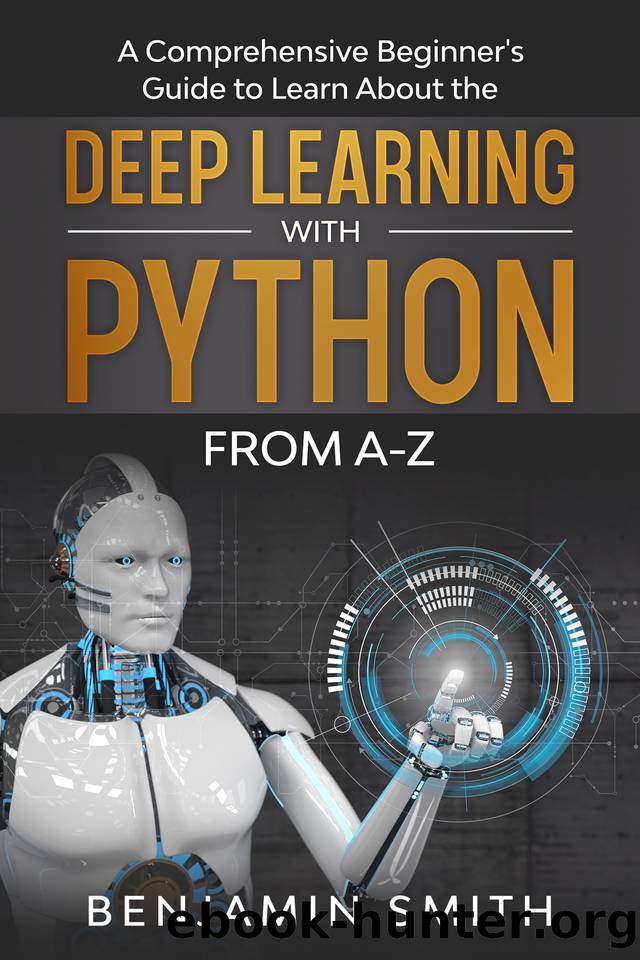DEEP LEARNING WITH PYTHON: A Comprehensive Beginner’s Guide to Learn the Realms of Deep Learning with Python from A-Z by Benjamin Smith

Author:Benjamin Smith [Smith, Benjamin]
Language: eng
Format: azw3
Published: 2020-04-25T16:00:00+00:00
Linear Regression
Linear regression is considered as the most basic kind of predictive analysis. The idea behind linear regression is an examination of two things; the first is if predictor variables perform a good job in terms of prediction of an outcome variable, and the second is what the variables that predict significantly and accurately the outcome variable. These kinds of regression estimates are generally used for explaining the relationship between a dependent variable and an independent variable.
In its simplest form, the equation that has a dependent and an independent variable can be condensed into the formula y = c + b*x. If we breakdown the equation, c is a constant, b is a regression coefficient, and y is the estimated dependent. The last one, ‘x,’ is the score on an independent variable.
Names differ for regression variables. You can dub them as the criterion variable, outcome variable, and endogenous variable. Linear regression is one of the simplest algorithms to understand if you want to dig deep into the basic machine learning concepts such as Cost Function, Gradient Descent, and Supervised Learning. In addition to this, Linear Regression makes it easier to make out the Logistic Regression algorithm. Linear Regression, simply put, falls into the category of a Supervised Learning algorithm, which has a goal of prediction of numerical values based on a given input of data. If we analyze it from a geometrical perspective, all data samples are points. Linear Regression, in general, attempts at locating parameters of a linear function, so that distance among different points and the mainline becomes the smallest possible. The algorithm which is used update of parameters is known as Gradient Descent.
Let’s analyze an example. If you have a dataset that consists of different apartment properties along with their prices in a particular area, you can use the algorithm of Linear Regression to find out a mathematical function that will attempt at calculating and estimating the value of your apartment based on the attributes. Another example can be taken of a fruit shop that sells fruit at a retail outlet and also supplies fruit across a city. You can use a linear regression algorithm to decrease the fruit waste.
Before doing the coding work, it is always good to have some kind of problem that you need to solve. It is quite possible to locate a large number of datasets on different websites, such as Kaggle. You also can source the data from the dominium.pl website. It is a search engine to find out different apartments. If you can think of any other resource to gather data to train the model, you can use that. The dataset will most likely be in the form of a .csv file. The main goal is training the Linear Regression model that will be capable of prediction of apartments’ prices.
The structure of data is as much important is the dataset itself is. You need to understand it carefully. If there are more features, it will be much harder to understand the data.
Download
This site does not store any files on its server. We only index and link to content provided by other sites. Please contact the content providers to delete copyright contents if any and email us, we'll remove relevant links or contents immediately.
| Computer Vision & Pattern Recognition | Expert Systems |
| Intelligence & Semantics | Machine Theory |
| Natural Language Processing | Neural Networks |
Algorithms of the Intelligent Web by Haralambos Marmanis;Dmitry Babenko(16234)
Jquery UI in Action : Master the concepts Of Jquery UI: A Step By Step Approach by ANMOL GOYAL(9386)
Test-Driven Development with Java by Alan Mellor(7735)
Data Augmentation with Python by Duc Haba(7608)
Principles of Data Fabric by Sonia Mezzetta(7378)
Learn Blender Simulations the Right Way by Stephen Pearson(7294)
Microservices with Spring Boot 3 and Spring Cloud by Magnus Larsson(7137)
Hadoop in Practice by Alex Holmes(6587)
RPA Solution Architect's Handbook by Sachin Sahgal(6515)
The Infinite Retina by Robert Scoble Irena Cronin(6215)
Big Data Analysis with Python by Ivan Marin(5933)
Life 3.0: Being Human in the Age of Artificial Intelligence by Tegmark Max(5512)
Pretrain Vision and Large Language Models in Python by Emily Webber(4894)
Infrastructure as Code for Beginners by Russ McKendrick(4652)
Functional Programming in JavaScript by Mantyla Dan(4436)
WordPress Plugin Development Cookbook by Yannick Lefebvre(4382)
The Age of Surveillance Capitalism by Shoshana Zuboff(4243)
Embracing Microservices Design by Ovais Mehboob Ahmed Khan Nabil Siddiqui and Timothy Oleson(4146)
Applied Machine Learning for Healthcare and Life Sciences Using AWS by Ujjwal Ratan(4135)
